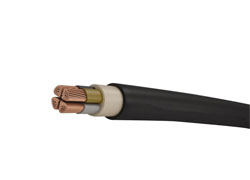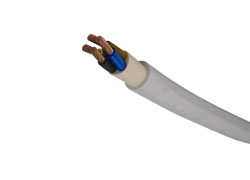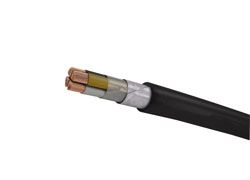The cable is usually a cable-like cable made up of several or several sets of wires (at least two in each group). Each set of wires is insulated from each other and often twisted around a center. The entire outer bread has a height. Insulated overlay. Multiplely installed in the air or underground, underwater, for telecommunications or power transmission. Cables can be divided into power cables, communication cables and control cables according to their uses. Then, when using the cable, is there any safety requirement? ? ? Its protection measures are how to store the specific content as follows:
Safety requirements
1. When the cable lines cross each other, the high voltage cable should be below the low voltage cable. The minimum allowable distance is 0.25 m if one of the cables is protected by a pipe or separated by a partition within 1 m of the intersection.
Safety protection measures when using wires and cables
2. When the cable is close to or intersects with the heat pipe, if there is insulation, the minimum distance between parallel and cross is 0.5m and 0.25m respectively.
3. When the cable crosses the railway or the road, it should be protected by a pipe. The protection pipe should extend 2 meters away from the track or road surface.
4. The distance between the cable and the building foundation should ensure that the cable is buried outside the building's scattered water; when the cable is introduced into the building, it should be protected by a pipe, and the protective pipe should also be outside the building's scattered water.
5. The distance between the cable directly buried in the ground and the grounding of the general grounding device should be 0.25~0.5 meters; the buried depth of the cable buried directly in the ground should not be less than 0.7m, and should be buried under the frozen soil layer.
Safety protection measures when using wires and cables
Safeguard
With the rapid development of the power cable buried laying project and the higher requirements for cable protection, the cable protective sleeve is made of polyethylene PE and high-quality steel pipe through sandblasting and shot blasting, dip or coating, and curing. Crafted. It is the most commonly used electrical insulation tube for protecting wires and cables. Because it has good insulation performance, high chemical stability, no rust, no aging, it can be widely used in adapting to harsh environments.
Protecting the cable with a cable protection sleeve can achieve the following advantages:
1, good corrosion resistance, long service life, can be used in wet saline soil.
2, flame retardant, good heat resistance, can be used for a long time at 130 °C without deformation, and does not burn in case of fire.
3, high strength and high stiffness. It can be used directly under the carriageway without the need to add a concrete protective layer.
4. The cable protection sleeve has certain flexibility whether it is pipe or pipe fitting, and can resist the damage caused by external heavy pressure and foundation settlement.
5, has good resistance to external signal interference.
6, the inner wall is smooth, does not scratch the cable. The design adopts a socket type connection for easy installation and connection. The rubber seal ring seal at the joint not only adapts to thermal expansion and contraction, but also prevents mud sand from entering.
Storage method
If the cable is to be stored for a long time, the following considerations should be made according to the location of the cable:
1, under the roof. The standard LAN cable can be used only when the cable is not directly exposed to sunlight or high temperature. It is recommended to use the pipe.
2, the outer wall. Avoid direct sunlight on the wall and human damage.
3, in the pipeline (plastic or metal). For example, in the pipeline, pay attention to the damage of the plastic pipe and the heat conduction of the metal pipe.
4, suspended application / overhead cable. Considering the sagging and pressure of the cable, which type of bundling is intended to be used, whether the cable is directly exposed to sunlight.
5, laying directly in the underground cable trench, this environment is the smallest control area. Cable trench installations should be regularly checked for dryness or humidity.
6, underground pipelines. In order to facilitate future upgrades, cable replacement and isolation from surface pressure and surrounding environment, isolation of auxiliary piping, auxiliary piping is a better method. But don't expect the pipeline to remain dry forever, which will affect the choice of cable type.
Henan Sanheng Cable Co., Ltd , founded in 2000, It is one of the top wire and cable manufacturers in China's wire and cable industry for nearly 20 years. the company has more than 5 production lines.
The production cable can be divided into more than 50 varieties and subdivided into 1000 specifications.All products have passed national certification, such as China compulsory certification, bv certification, Nigerian SONCAP certificate, China national industrial certification, etc. China national industrial production license, etc.It also has the ability to produce products that meet international standards, such as iec, ce, rohs, etc.
If you want to buy wires and cables, you can ask the customer service staff and we will get back to you as soon as possible.
-

600 1000V CU XLPE Power Cable
Conductor:Bare Copper Conductor of Class 1/2 (Solid)
Insulation:XLPE Compound
Insulation Color:Red, Blue, Grey, Yellow/Green or as request
-

600-1000V AL XLPE Power Cable
3500 V:Bare Aluminum Conductor of Class 1/2 (Solid)
Insulation:XLPE Compound
Insulation Color:Red, Blue, Grey, Yellow/Green or as request
-

600-1000V Flexible Power Cable
Conductor:Bare Copper Conductor of Class 5 (Flexible)
Insulation:PVC Compound
Insulation Color:Red, Blue, Grey, Yellow/Green or as request
-

600-1000V SWA Armoured Cable
Conductor:Bare Copper Conductor of Class 1/2 (Solid)
Insulation:XLPE Compound
Insulation Color:Red, Blue, Grey, Yellow/Green or as request





